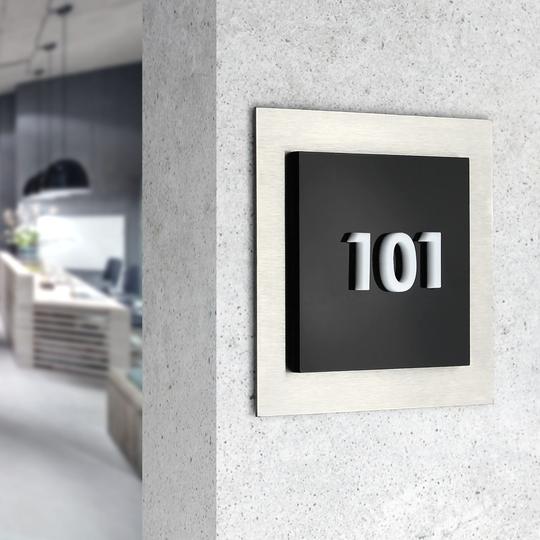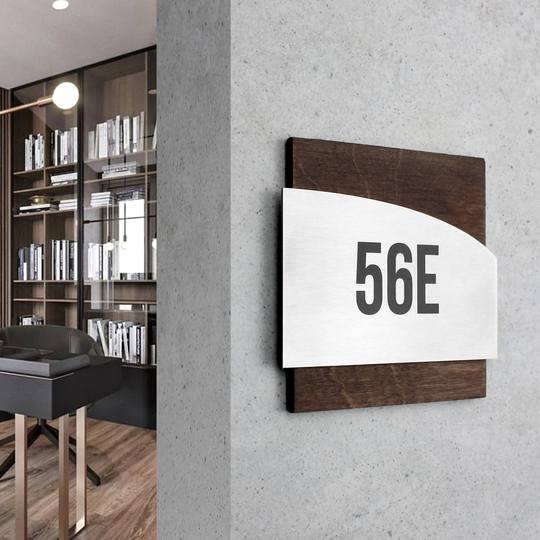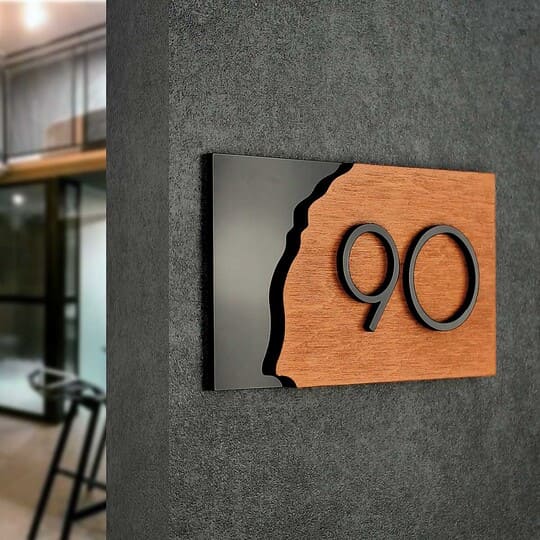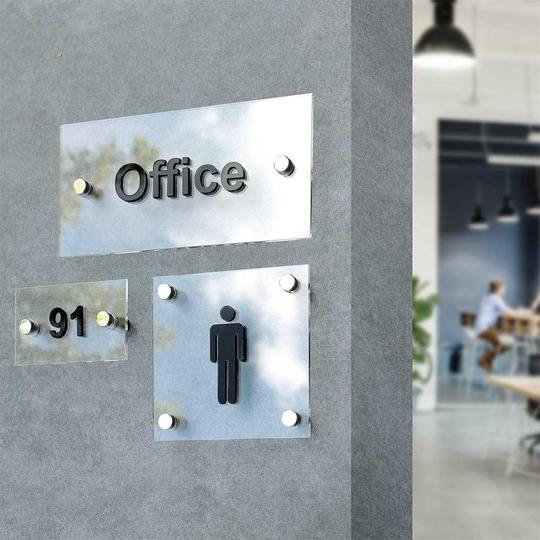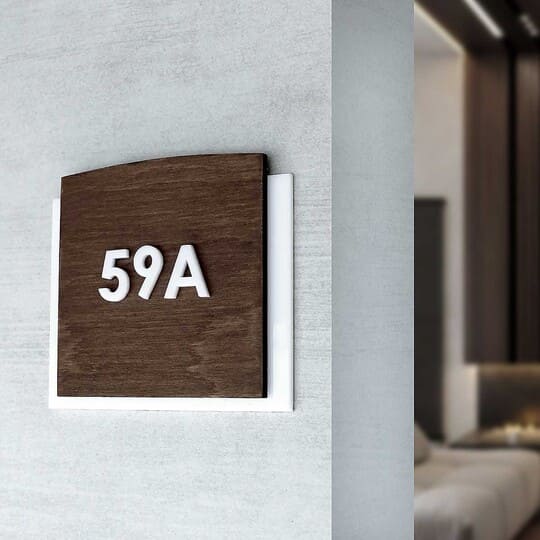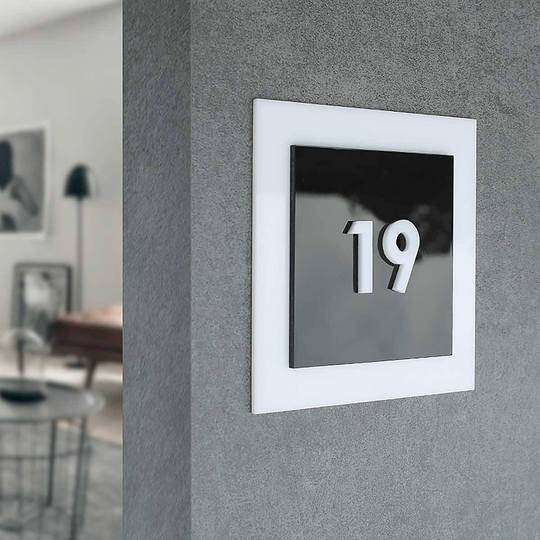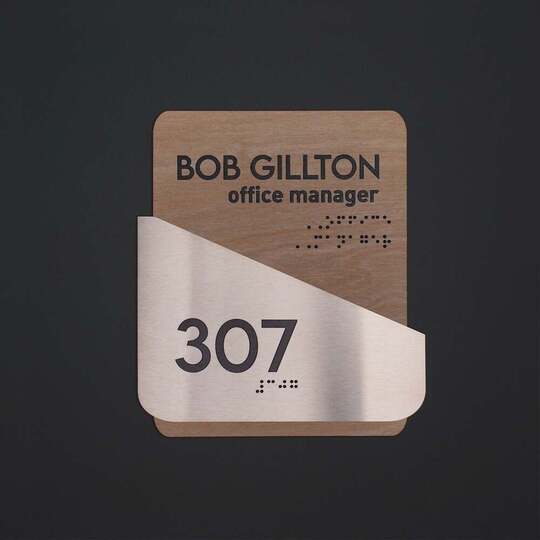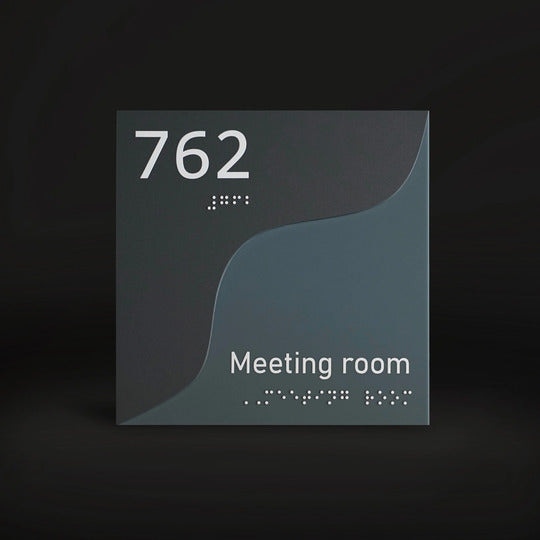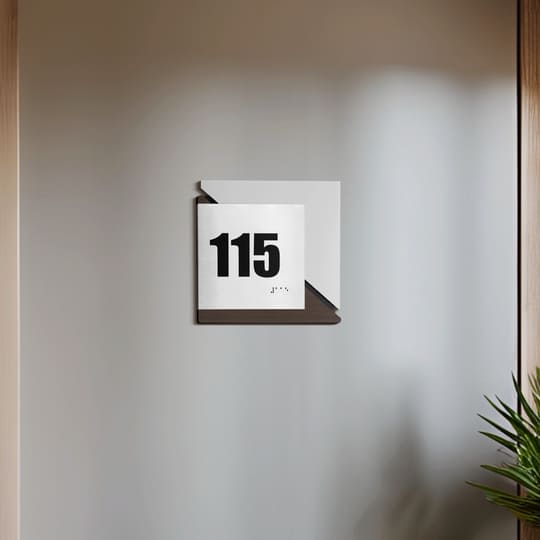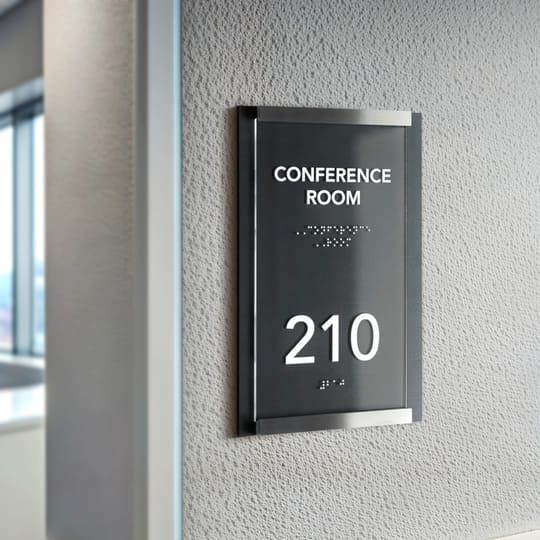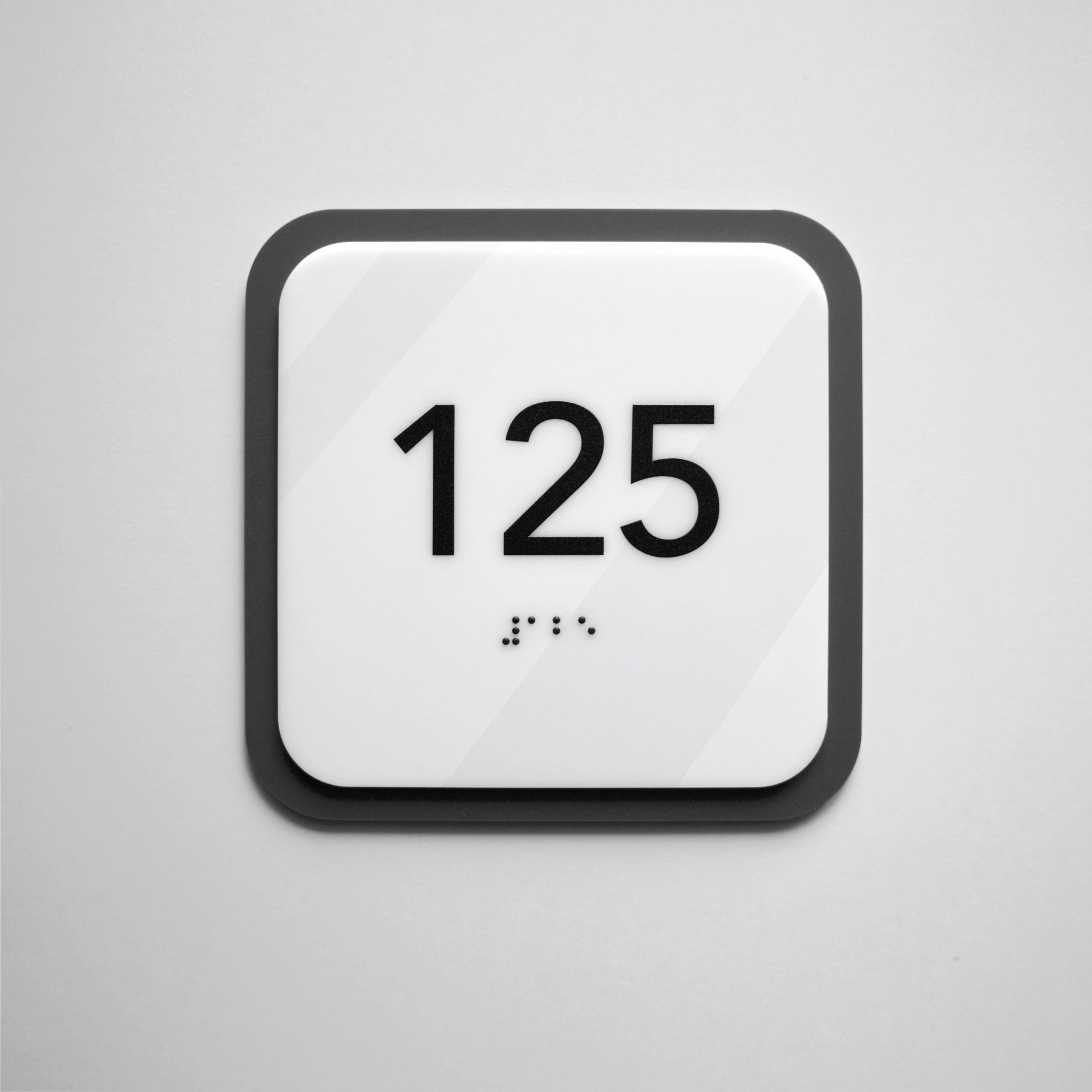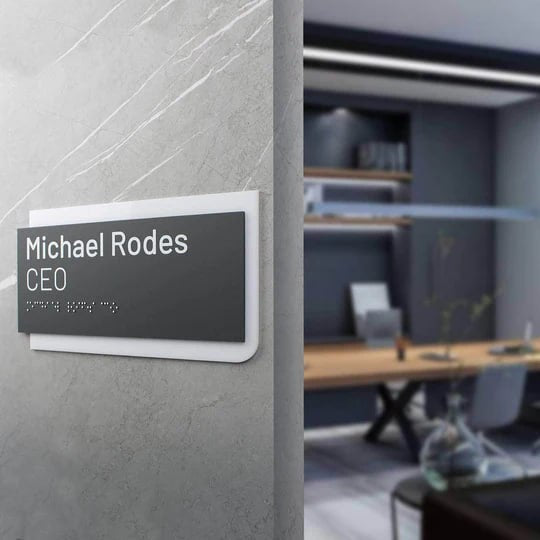
How to Maintain Metal Door Signs and Numbers: Simple Tips for Years of Use
In the business environment, details shape an atmosphere of trust, demonstrate attention to small things, and create a sense of order. Metal door signs and door numbers are among such elements. They facilitate easy identification of rooms and emphasize the company’s style, neatness, and overall professionalism.
The Bsign brand creates exactly this type of product: custom stainless steel signs, wood, and acrylic ones that combine aesthetics and functionality. Each piece is handcrafted with meticulous attention to its lines, typography, and texture. We help venues, hotels, offices, and residential complexes express their brand identity through details that stay with them forever.
However, even high-quality metal signages can lose their original shine over time, become dull, stained, or scratched. The issue is not the material itself but improper maintenance. The good news is that stainless steel products can be kept looking “like new” through simple actions that require neither significant time nor investment. This type of low-maintenance care ensures a flawless appearance for many years.
This article explores why maintaining metal products is important, which care rules to follow, what to avoid, how to clean surfaces without damaging the metal, and a few simple habits that will help preserve the shine and presentable appearance of metal elements for years to come.
Signage maintenance as part of a professional image
Well-maintained stainless steel door numbers and plates are the first elements seen by visitors, guests, or partners. They create an immediate impression of orderliness and attention to detail, even before any interaction with the team. A clean surface without stains or scratches is an essential component for any business that seeks to maintain trust and consistency.
If the plate is neglected, even a stylish interior loses its coherence. Instead of a premium look, it creates an impression of neglect. This matters for companies because details influence how a brand is perceived. The right choice and regular maintenance of such products are therefore as integral to corporate culture as customer service or staff appearance.
Regular care helps minimize the risk of corrosion, preserves functionality while emphasizing the company’s high standards.

How to Do Sign Cleaning Right: A Simple Step-by-Step Guide
To keep decor elements looking neat and well-maintained, there is no need to use expensive or complex products. The main rule is gentleness. Excessive force or harsh chemicals can damage the surface much faster than the passage of time.
Below is a step-by-step guide to help you maintain your plates in excellent condition, even in high-traffic areas.
Basic Care Kit (Keep it Handy)
-
• Soft microfiber cloths (2–3 pieces for different areas);
-
• Spray bottle with clean water;
-
• Neutral liquid soap (e.g., a dishwashing gel or mild cleaning solution);
-
• Soft brush with short bristles or a toothbrush for seams;
-
• Separate dry cloth for polishing;
-
• Small bottle of specialized stainless steel spray/polish (if needed).
Step-by-Step Instructions (Quick and Flawless)
Before starting the care process, prepare the surface: gently remove dust with a dry microfiber cloth — this takes no more than a minute but prevents scratches during subsequent steps. Next, prepare a mild solution in a spray bottle: add only 1–2 drops of soap to 250 ml of warm water. Do not spray the solution directly onto the plate — instead, apply it to a cloth to prevent liquid from entering the seams. For hard-to-reach areas — such as corners, seams, and openings — a small brush works best.
After surface care, immediately dry the product with a separate clean cloth, paying special attention to the edges and mounting points.
Finally, if a shine needs to be restored, apply a thin layer of specialized stainless steel polish once or twice a year to enhance the luster and create a light protective barrier.

How Often to Clean (Guideline Based on Location Type)
-
• Front doors / external house numbers: light care once a week; regular maintenance check once a month.
-
• Lobbies, hotel corridors, office hallways: dusting 1–2 times per week; full care once a month.
-
• Rooms with low activity (offices, private spaces): dusting every two weeks; wet cleaning once a month.
-
• Near kitchens or coffee areas: surface cleaning 2–3 times per week; remove grease stains immediately upon appearance.
The local climate also plays an important role. In regions with high humidity or frequent temperature fluctuations, surface rust may appear — a thin layer of oxidation that does not harm the steel but affects its aesthetic appeal. Under such conditions, surface maintenance should be done every 3–4 days, with polishing and inspection of mounting points once a month.
Tips for Proper Use of Signs
When cleaning, it is advisable to follow a few technical tips. Work under diffused light, which allows you to see the true condition of the surface and avoid missing spots.
For convenience, you can implement a maintenance schedule for different areas — weekly or monthly — depending on the level of use.
Use separate cloths for metal and other materials (wood, acrylic) to prevent transferring micro-contaminants.
It is advisable to inspect outdoor plates after strong winds or precipitation, as this helps prevent damage to the mounting points.
When to Call Professionals or Plan a replacing
If a stain does not come off after several standard care attempts, it is best to stop further cleaning to avoid damaging the surface. The same applies if there are visible deformations, loose mounting points, or changes in the metal’s texture. In such situations, it is advisable to seek professional assistance.
When updating the design, it is often more practical to replace a plate that has lost its readability or structural integrity rather than attempt to restore it.
This approach helps maintain a neat, attractive appearance of the decor element with minimal effort, ensuring long-term resistance and protection against corrosion.
If you would like to learn more, explore our signage care tips.
 What to Avoid When Maintaining Stainless steel signages
What to Avoid When Maintaining Stainless steel signages
Even the most sturdy and durable signs can lose their appearance if maintained incorrectly. Stainless steel is a material that is forgiving in many ways, but not entirely. Its surface features a delicate polish, and any aggressive intervention may damage the shine or alter the structure of the metal.
To avoid such issues, it is important to know which actions are strongly discouraged.
-
• Do not use abrasive sponges or powders.
Abrasive materials remove the top polished layer of the steel, causing it to lose its natural light-reflecting qualities. Dust and moisture accumulate more quickly on damaged areas, which over time leads to discoloration of the metal. -
• Do not use general-purpose household cleaners.
Many cleaning products designed for glass, ceramics, or tiles contain alcohols, ammonia, or salts that are unsuitable for stainless steel. These formulas leave an invisible residue that causes the surface to appear “streaky” under artificial lighting. If a more intensive cleaner is required, choose only one specifically labeled as safe for stainless steel. -
• Do not place hot objects on the sign, or use a hair dryer or heater to dry it.
Sudden temperature changes can deform adhesive layers or compromise the mounting of the plate on its surface. Stainless steel does not deform by itself, although excessive heating can cause lacquer coatings or fonts to lose their color intensity. -
• Do not use chemical wipes or wet cleaning wipes of unknown composition.
Some wipes contain fragrances and acids that can leave stains or shiny “halos” when they interact with metal. If using wet wipes, ensure that they are specifically designed for stainless steel surfaces. -
• Do not apply tape or protective film to the product during renovation or painting.
Adhesive residues often react with metal, leaving dull marks. These marks are particularly visible on glossy plates and are difficult to polish out. It is advisable to cover decor elements with paper or fabric without using adhesive materials.

Long-term Benefits of Proper Care
Regular care is an investment in durability. When products retain their original shine, they remain a visible element of the environment that conveys a professional impression for many years. Systematic maintenance minimizes the need for repair or replacement because the surface preserves its strength and aesthetic appeal for a longer period.
The space retains a harmonious look, and all patterns, letters, and font remain clear.
Additionally, the brand gains visual consistency and a reinforced sense of style, which is especially important for companies aiming to maintain a unified design and high quality in every interior element. As a result, professional door signs remain recognizable even after years — they retain the clarity of lines, shine, and elegant appearance.
As a result, such details contribute to the overall reputation of the business. Visitors subconsciously perceive orderliness in the small elements as a reflection of the company’s organization, reliability, and high professional standards.

Metal Signs as an Accent in the Space
When stainless steel door number signs combine minimalist design with a flawless finish, they become a focal point of any interior.
Proper cleaning, moisture protection, and regular polishing extend the lifespan of plates and maintain a professional impression.
In modern business, even small details can influence brand perception. When metal business signs shine just as they did on the day they were installed, it is the clearest proof of stability, responsibility, and attention to detail.
If you want your space to look impeccable down to the smallest detail, contact the Bsign team. We will help create a custom solution — from address numbers to unique business products that combine aesthetics, functionality, and longevity. We also provide guidance on implementing ideas that highlight your brand’s character and give your space a professional significance. Our designers know how to match materials, textures, and colors to create cohesive visual accents that become the hallmarks of your company.
